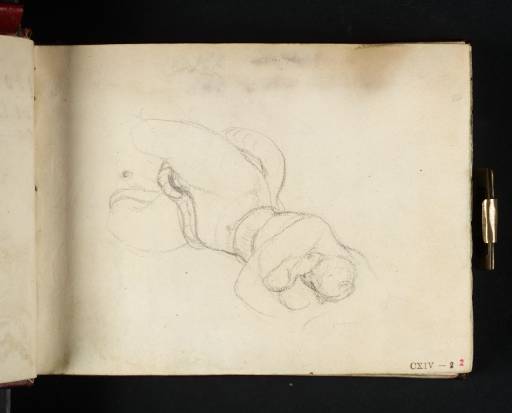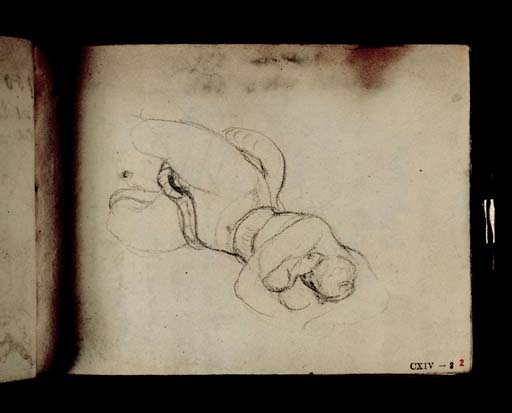Joseph Mallord William Turner A Nude Woman Entwined with a Snake c.1808-11
Image 1 of 2
Joseph Mallord William Turner,
A Nude Woman Entwined with a Snake
c.1808-11
Joseph Mallord William Turner 1775–1851
Folio 2 Recto:
A Nude Woman Entwined with a Snake circa 1808–11
D07961
Turner Bequest CXIV 2
Turner Bequest CXIV 2
Pencil on white wove paper, 87 x 117 mm
Part watermark ‘J Wha | 180’
Inscribed by John Ruskin in red ink ‘2’ bottom right
Stamped in black ‘CXIV – 2’ bottom right
Part watermark ‘J Wha | 180’
Inscribed by John Ruskin in red ink ‘2’ bottom right
Stamped in black ‘CXIV – 2’ bottom right
Accepted by the nation as part of the Turner Bequest 1856
References
1909
A.J. Finberg, A Complete Inventory of the Drawings of the Turner Bequest, London 1909, vol.I, p.311, CXIV 2, as ‘Nude female figure in embraces of a serpent’.
1989
Ann Chumbley and Ian Warrell, Turner and the Human Figure: Studies of Contemporary Life, exhibition catalogue, Tate Gallery, London 1989, p.13.
1997
James Hamilton, Turner: A Life, London 1997, pp.110 and 111, as ‘Writhing serpent with figure’.
2003
Ian Warrell, ‘Exploring the “Dark Side”: Ruskin and the Problem of Turner’s Erotica’, with ‘A Checklist of Erotic Sketches in the Turner Bequest’, British Art Journal, vol.4, no.1, Spring 2003, pp.17, 18, pl.8, as ‘Nude female wrestling with a serpent’.
This study has been described as a variation on ‘traditionally erotic themes such as Leda and the Swan’,1 apparently the subject of a drawing in the Academies sketchbook (Tate D40640, D05170; Turner Bequest LXXXIV 4 verso–5). James Hamilton has set it and other sketches in the context of Turner’s early ‘monster’ paintings2 such as Jason, exhibited in 1802 (Tate N00471)3 and Apollo and Python, exhibited in 1811 (Tate N00488),4 although both show male protagonists at a distance from the respective creatures.
Turner could have taken his subject from John Dryden’s Alexander’s Feast: Or the Power of Musique. An Ode, in Honour of St. Cecilia’s Day (1697), included in the comprehensive 1795 Anderson edition of British Poets, which he may have owned as early as 1798.5 The relevant passage is as follows:
The song began from Jove,
Who left his blissful seats above,
(Such is the power of mighty love.)
A dragon’s fiery form bely’d the god:
Sublime on radiant spires he rode,
When he to fair Olympia [sic] press’d:
And while he sought her snowy breast:
Then, round her slender waist he curl’d,
And stamp’d an image of himself, a sovereign of the world.6
Who left his blissful seats above,
(Such is the power of mighty love.)
A dragon’s fiery form bely’d the god:
Sublime on radiant spires he rode,
When he to fair Olympia [sic] press’d:
And while he sought her snowy breast:
Then, round her slender waist he curl’d,
And stamp’d an image of himself, a sovereign of the world.6
This relates the story of Olympias, the historical mother of Alexander the Great, and her mythical impregnation by Zeus (the Roman Jupiter or Jove) in the form of a snake. Dryden’s ancient sources were probably the Philippic History of Justin (Marcus Junianus Justinus) and Plutarch’s Lives.7 The episode had been the subject of an erotic fresco by Giulio Romano (?1499–1546) at the Palazzo del Te, Mantua, derived from an ancient image and later engraved, although Zeus is there shown as a snake only below the torso.8
Amongst other Western mythological and religious iconography, in Greek myth the Medusa had snakes in place of her hair, and the serpent in the Garden of Eden had sometimes been shown as half-snake, half-woman in works which Turner would or could have known, for example the temptation of Adam and Eve in Michelangelo’s Sistine Chapel ceiling frescoes (1508–12) or the medieval carving on the west front of Notre Dame, Paris. Later nineteenth-century treatments include the related mythological figure of Lilith, entwined with a snake in an 1887 oil by John Collier (Atkinson Art Gallery, Southport), and well-known Symbolist paintings such as Franz von Stuck’s Sin of 1893 (Neue Pinakothek, Munich). As Ian Warrell has noted, the ‘sexual undercurrents’ of Turner’s subject ‘are readily apparent, even to those unfamiliar with Dr [Sigmund] Freud’.9
Matthew Imms
January 2012
James Hamilton, Turner: The Late Seascapes, exhibition catalogue, Sterling and Francine Clark Art Institute, Williamstown 2003, p.107.
Martin Butlin and Evelyn Joll, The Paintings of J.M.W. Turner, revised ed., New Haven and London 1984, p.18 no.19, pl.15.
See Andrew Wilton and Rosalind Mallord Turner, Painting and Poetry: Turner’s ‘Verse Book’ and his Work of 1804–812, exhibition catalogue, Tate Gallery, London 1990, p.113.
Robert Anderson (ed.), The Works of the British Poets, London 1795, vol.VI, p.174; also given in John Hughes’s similar setting in ibid., vol.VII, p.309; see also Vinton A. Dearing (ed.), The Works of John Dryden, vol.VII, Berkeley 2000, p.4.
How to cite
Matthew Imms, ‘A Nude Woman Entwined with a Snake c.1808–11 by Joseph Mallord William Turner’, catalogue entry, January 2012, in David Blayney Brown (ed.), J.M.W. Turner: Sketchbooks, Drawings and Watercolours, Tate Research Publication, December 2012, https://www


